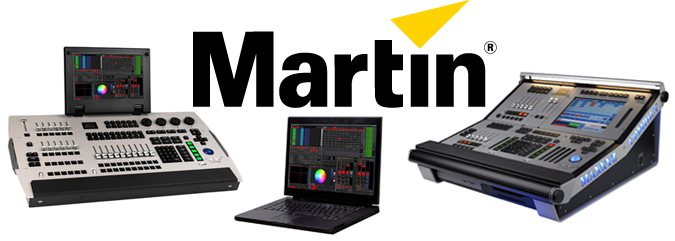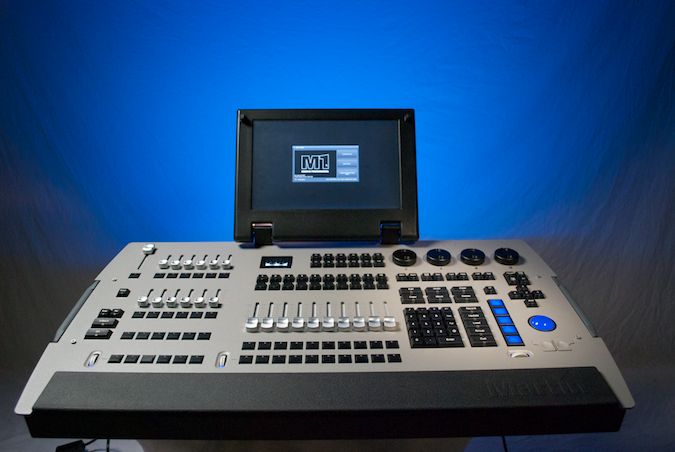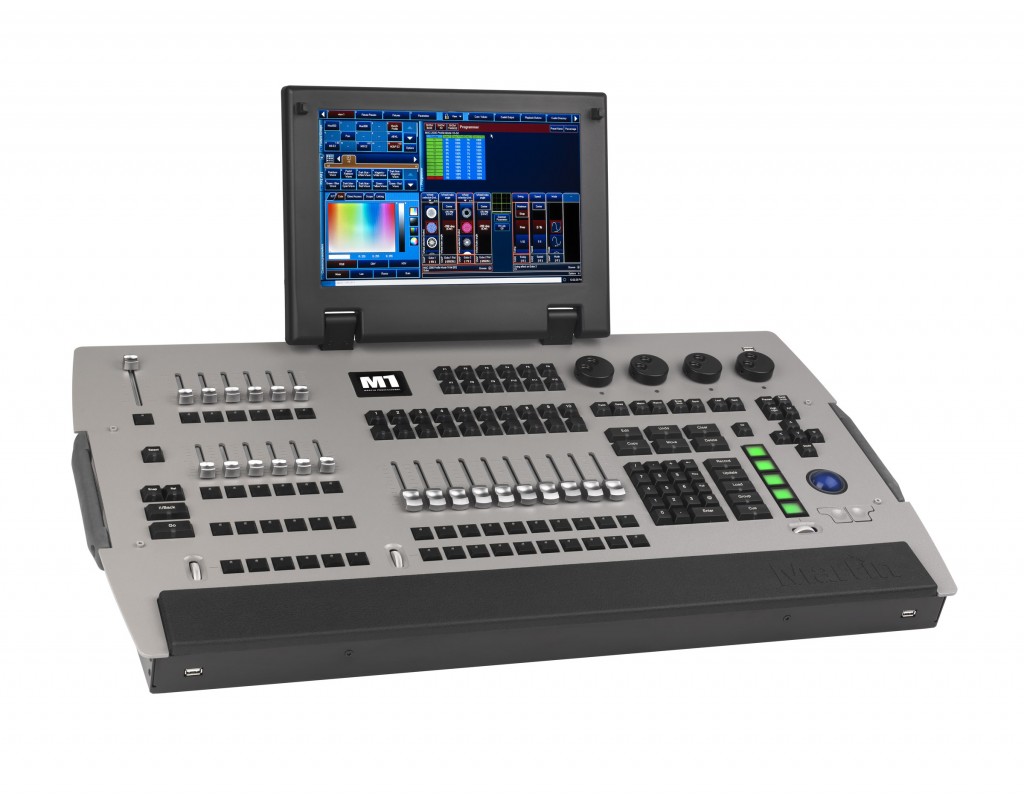Martin Releases v2.80 for M1, M-PC & Maxxyz Desk AND Expands M1 to 16 Universes

This is what I love about lighting desk as of late. You want a new feature or more capabilities, just wait for the next FREE software update! Since most desk these days are computer passed, getting new features on your desk of choice is as simple as running an update. Martin Professional is a prime example of that with the release of version 2.80 for the M1, M-PC and Maxxyz desk.
Here is more from Martin:
By adding a host of new features, including full RDM support and introducing a new DMX licensing system, version 2.8 software for Martin’s M1, M-PC and Maxxyz lighting consoles is a milestone release that further enhances the value of Martin’s professional controller line for its rapidly growing user base.
Over the past year, Martin has positioned its controller systems as a feature-packed, powerful, but affordable solution in the professional lighting market by offering attractive solutions without compromising the usability and quality of the hardware.
RDM Support
Martin continues its company-wide support of the RDM standard by adding a comprehensive RDM control system to its controllers. Users can now monitor RDM-enabled fixtures connected to a Martin console either directly inside the software or remotely from a website hosted inside the console. This features the ability to download status reports across the Internet, showing real world usability of RDM and adding real value for the customer. RDM is supported over the integrated DMX ports and over Artnet.
DMX Remote Input and Capture
It is now possible to receive up to 16 Universes of DMX input for remote control of cues, fixture levels or simply to manage HTP and LTP merging of an additional lighting desk into the system. 16 Universes can also be captured into the console programmer to read out cues from existing shows into the console. The comprehensive DMX Input feature set allows Martin’s controllers to stay at the heart of the DMX system while having full control over the merging behavior.
Quick-Peek
A new innovative feature is the ability to “peek” at any screen view. Holding down a screen-view button for more than two seconds automatically enters the Quick-Peek function. The view reverts to the original one once the button is released, allowing for quick glances at information on the desk while reducing unnecessary button presses.
Customizable Function Keys
Martin controllers are known for their elegant and uncluttered hardware surfaces. To enhance fast access to often used functionality, all consoles offer a variety of F-Keys which now have a newly designed management system for fast configuration by the operator. Functions include Group and Preset selects, console locking, semitransparent onscreen keyboard, and many more useful options right at a user’s fingertips.
Martin One-Key DMX Licensing
With Version 2.80, the Martin M1 console increases its DMX support from 12 to 16 Universes. Additional Universes to the 4 included in the standard package of the desk can be added by purchasing a license package, connecting Martin’s Ether2DMX8 devices or by connecting a Martin One-Key with an M-PC license. More Universes are simply added dynamically as soon as the additional license is seen by the M1 console. This allows Martin M1 programmers to bring their own Martin One-Key and unlock any M1 console immediately for their shows, independent of the DMX Universes activated in the console.
Version 2.80 also increases existing Maxxyz PC and M-PC systems to 64 Universes from 32, and includes balanced multi-threaded DMX processing for modern multi-core CPUs. Version 2.80 software is available at www.martin.com.
Review: Martin M1 Lighting Desk

At ProLight + Sound this year, Martin Professional announced to the world their latest control product, the M1 Lighting Desk. Martin is boasting the M1 as the next generation of Lighting control in the lighting industry. With the form and function of the M1, it is pretty clear why they say that.
The M1 is a compact, portable and feature rich lighting desk compared to Martin’s other control desk options, the Maxxyz series of desks. There are numerous options and configurations available in the Maxxyz line up of desks, but nothing as affordable, lightweight and ready out of the box like the M1.
From the design and features built into the M1, I feel that Martin targeted the M1 to a specific portion of the market, the smaller touring market. At just under 32lbs., in a metal housing, the M1 is not only built tough, but looks tough. With it’s solid construction, the M1 should have no troubles handling anything a life on the road will throw at it.
[singlepic id=1101 w=320 h=240 float=left]On the surface of the M1, there is control coming at you where ever you look at the desk. The M1 has plenty of sliders, executors and paging wheels to make your head spin at first glance. Off to the far left, you have your theatrical style main playback. Just off to the right of the main playback are twelve single sliders with a function assignable button and twelve more single assignable buttons just below that. This is the first of two section of play backs. In the second section there are 10 playback faders, each with four function assignable functions right dead center of the desk for easy execution. No matter where your hands fall on the desk or what type of playback you might need, you’ll never be to far away from a playback.
If you did the math quick enough, that means that there are only thirty four places on the M1 to assign something for a playback. Don’t forget about the paging wheels. The ten center playbacks and the twenty four playbacks to the right have their own paging wheel to access even more playback underneath, up to 100 pages.
The M1 makes available 1000 cuelist which can be assigned to sliders with fade control or playbacks with control buttons. On top of those 1000 cuelist, you have the ability to add as many cues as you like with no restriction based on cue count. Just a bit of playback space no?
To help make the M1 even more lightweight and portable, Martin included a fold up 13” touch screen. No more worrying about if the monitors made it to the show, it’s built into the desk.
[singlepic id=1106 w=320 h=240 float=left]At the time of the review, the M1’s software was still in beta and wasn’t able to run a second monitor for more heads up display. Martin has already fixed this issue and updated the software to were the display port on the back of the M1 offers the ability to add a second monitor which also support ELO USD touch screens.
Under the hood of the M1 is an industrial motherboard with an dual core Intel Processor, integrated graphics all in a modular construction for easy repairs and replacement if something should ever go wrong. The M1 also features a 2.5” SATA hard drive at eighty gigs in size which is more then plenty to run the OS and save plenty of backups to your shows.
Speaking of Operating Systems, the M1 works off an industrial version of Windows XP embedded. Before the end of 2010, Martin is expecting to upgrade to Windows 7 embedded giving the M1 the power and performance of Windows 7. This will be a free software update from Martin. Now I tried my hardest, it was impossible to “break into” the Windows side of the desk, meaning Martin has locked down the core OS pretty well. Since the desk is based on Windows, saving and opening shows off of a USB jump drive is just as simple as on a PC.
[singlepic id=1105 w=320 h=240 float=left]Control on the M1 should never become an issue. Starting off with four universes of DMX right off the bat, smaller shows should have no problem controlling any small to medium sized moving rig. As time goes on, adding fixtures to any rig might cause a hiccup in control as those four universes of DMX quickly become filled. Not a problem with the M1. As your rig grows so can the M1’s universe count. While the M1 starts off with only 4 universes, you can add universes to the desk via universe licenses, up to 12 total via networking and Artnet.
For most of us, 6,144 parameters of DMX might be a bit much for our needs, but as time goes by and your rig keeps growing, you might out grow the M1. In the distant future when that time comes, you may have to upgrade to one of Martins Maxxyx line up of consoles. The best part is, you will not have to learn an new programing syntax! The M1 is the same programing syntax as Martin’s Maxxyz consoles. In fact, it is the same operating system! Now, if you are already a Maxxyz programmer, perfect, you already know the M1.
The M1 is based on the Maxxyz, layout and function of the desks are exactly alike. The M1 utilizes programmer and playback state of the console. The programmer side being where we enter the changes we like and then store them into some sort of playback whether that be a cue or submaster. The playback side of the desk is just as it sounds where these cue list, cues, effect, whatever you like to call them are, you guessed it played back.
Now if you feel that you need additional playback sliders at your finger tips and thirty four is just not enough, why not add a Max Module Playback, Button or Submaster Module? Since the M1 is based on the Maxxyz Console, the desk is easily expandable to your needs with addition sliders, executor buttons or submasters.
[singlepic id=292 w=320 h=240 float=left]You can even connect the M1 to a wireless access point and wirelessly connect an iPad, iPhone or iPod touch and run the free app from Martin, the MaxRemote. Just like any console remote like the MaxRemote, you have to have a little bit of network savviness to connect everything correctly. As a lighting professional in the digital age, this type of responsibility is required and demanded of us more and more.
After setting everything up correctly on the network, and on the iPad/iPhone/iPod Touch, using the MaxRemote to focus, program and run a show is fairly easy and straight forward after learning the Maxxyz syntax. The MaxRemote is a useful tool when connected to the M1 to fine tune focus points while on stage and away from the desk.
Overall, the M1 is a rugged, well designed and laid out touring desk. It has power behind it that can control almost any medium sized rig with no problem and has the ability to grow with your rig. I feel that the M1 was designed to be a busking desk and it shows with the amount of playbacks offered on the surface. It also offers the ability to playback as a traditional theatrical style desk making it very flexible. The M1 can be used in a wide variety of venues from traditional theatre, live performance, corporate events, the list can go on and on.
Don’t believe me, the M1 has already seen some action on some larger shows such as the World Cup. Not a bad start for a new console making it’s way to primetime in less then six months. I expect to see and hear about the M1 on many more shows and events of this size. You can follow the M1’s adventure on Facebook. You can also see the M1 up close and personal on the Martin Roadshow which is touring around the country this summer.
To learn more about the Martin M1 Lighting Desk, visit www.martin.com. Hve you had a chance to work on the Martin M1 Desk? What do you think? I would love to hear your comments about the desk and of course, this review.
[nggallery id=61]
Update: Martin M1 Lighting Control Desk with Photo

FINALLY, a name has been announced about Martin’s new control desk, it’s called the M1. Martin has even added the M1 to there web site well before the desk unveiling at ProLight + Sound in Frankfurt Germany next week. Looking over the “manual” that Martin has made available, it looks as though development or at least the proper manual is still in the works. All that was found in the manual are more features, control interfaces and physical layout of the desk.
Maybe well see more about how the M1 desk functions before ProLight + Sound.
LatestHeadlines
- Upgrading Your Toolbox: City Theatrical DMXcat-E and DMXcat Multi Function Test Tool
- Claypaky Bringing Back the Sexy to Par Cans with the Midi-B FX
- Ayrton Evolves the Cobra, the Cobra2 Developed for the US Market
- MA Lighting Intros grandMA3 onPC Fader Wing and DIN-Rail Nodes
- Live Events LEVL Up Fest: A Festival to Aid our Industry